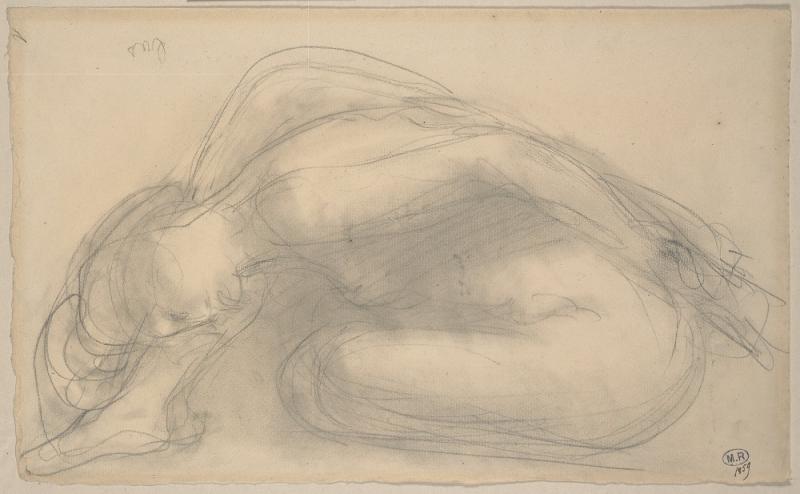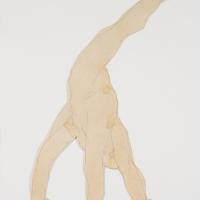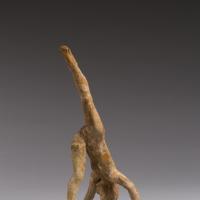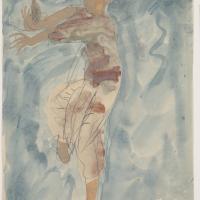Rodin and Dance: The Essence of Movement, Courtauld Gallery | reviews, news & interviews
Rodin and Dance: The Essence of Movement, Courtauld Gallery
Rodin and Dance: The Essence of Movement, Courtauld Gallery
Inspiring show highlights experimental studies of the female form in motion

This is an inspired and beautifully curated exhibition. It is subtitled The Essence of Movement, but it could equally be called The Essence of Art. What marks it out is not only the sensitively selected and tightly focused content, but also its close exploration of Rodin’s artistic process.
The exhibition takes as its subject Rodin’s fascination with dance. His drawings of c. 1900-6 capture the trembling excitement of the vibrating hand and body movements of Cambodian and Japanese dancers, and the ways their bodies activate the space around them. A favourite Japanese actress, Hanako (whose face also captivated Rodin, resulting in a series of masks and busts), poses nude in several iconic poses. Later, other lithe nude models, in various uninhibited acrobatic positions, are scrutinised in rapid pencil sketches (Rodin notoriously did these while not looking down at the paper, intent only on his model) so that their poses are captured in the most spontaneous and minimal sense. Sometimes the sketches are graphic in their anatomical detail, but then they are progressively traced and pared down, with one – a nude in "tripod" form – eventually liberated from the page as a "cut-out" (prior to being modelled in malleable clay). (Pictured below: Rodin drawing Cambodian dancers, 1906 © Musée Rodin (photo: Jean de Calan.)
 Rodin’s attitude to dance is profoundly different to that of his contemporaries, notably Edgar Degas. In June 1812, the patron and collector Count Henry Kessler was shown Rodin’s studies of "a very supple, girl, a kind of acrobat, whose poses provide all kind of entirely new and bizarre arabesques". The exhibition has identified the inspiration for these studies and a series of small-scale sculptures (now collected together by the Musée Rodin under the title "Mouvements de danse") – a French girl called Alda Moreno, who made her living as both an acrobat and exotic nude model, and who had posed for Rodin in 1903.
Rodin’s attitude to dance is profoundly different to that of his contemporaries, notably Edgar Degas. In June 1812, the patron and collector Count Henry Kessler was shown Rodin’s studies of "a very supple, girl, a kind of acrobat, whose poses provide all kind of entirely new and bizarre arabesques". The exhibition has identified the inspiration for these studies and a series of small-scale sculptures (now collected together by the Musée Rodin under the title "Mouvements de danse") – a French girl called Alda Moreno, who made her living as both an acrobat and exotic nude model, and who had posed for Rodin in 1903.
She was the companion of one of Rodin’s colleagues, but went missing in 1905. Rodin searched for her high and low, in order to get her to model for him again: then a friend tipped him off. Nude photographs of her were in the November (1905) issue of the coyly titled magazine Le Nu académique, a copy of which Rodin hastily purchased and which has been tracked down for this exhibition.Here we see Moreno in the exaggerated arabesque pose, with one foot held to her head, the other planted to the ground, that Rodin was to make his own. Rodin called the series of drawings and small models that he made, inspired by Moreno (she was eventually found and posed for him some years later), "the creation of woman". (Pictured below left: Le nu académique journal of 1905 showing the newly discovered photos of Alda Moreno in the pose of "Dance Movement A", 1905, © Agence photographique du Musée Rodin - Pauline Hisbacq. Pictured below right: Dance Movement A, c. 1911. Musée Rodin).
 Rodin explained to Kessler that he saw in these bizarre poses "something like the stages of an evolution, transitions leading from the animal world to woman". In the exhibition, we can fully explore this remarkable transition, as the woman is reduced to something primitive, almost animal – and then, as Rodin said, "crawls out as though from a cocoon". Rodin kept these works very secret, including an "entire glass case full of small figures", which the curators have recreated as the main "event" of the exhibition. Rodin realised that some people might find these studies and figures obscene, but – as Kessler relates - to the artist they were "pure mathematics". If there was any "passion" involved, it was only the expression of "unknown passions" contained in the movements themselves, "which we can’t imagine but might be possible – passions that are not human".
Rodin explained to Kessler that he saw in these bizarre poses "something like the stages of an evolution, transitions leading from the animal world to woman". In the exhibition, we can fully explore this remarkable transition, as the woman is reduced to something primitive, almost animal – and then, as Rodin said, "crawls out as though from a cocoon". Rodin kept these works very secret, including an "entire glass case full of small figures", which the curators have recreated as the main "event" of the exhibition. Rodin realised that some people might find these studies and figures obscene, but – as Kessler relates - to the artist they were "pure mathematics". If there was any "passion" involved, it was only the expression of "unknown passions" contained in the movements themselves, "which we can’t imagine but might be possible – passions that are not human".
Models bend, stretch, arch, curl in on themselves, contort themselves – sometimes they seem to be chrysalides, other times frogs, flaming torches or flowers (see gallery overleaf). With outstretched limbs and double-jointed hands that bend counter to any norm, the models also demonstrate enormous poise. Two poses (captured in two headless figurines modelled in clay and then preserved in plaster) then become the parents of an entire series of clay figurines: the first Moreno’s "ascending" arabesque, the other a "lunging" pose. Having created two parent figures (which in one of the resulting sculptures are conjoined in a strange pas-de-deux), Rodin then sections them into body parts (arm, legs, torsos). These body parts are then press-moulded and recombined to create a dozen clay figures in extreme, leaping and twisting, dislocated movement, with the addition of a head (cast from an earlier piece – The Head of a Slavic Woman). Now Rodin’s focus is on cantilevered forms, pivots, and establishing a precarious equilibrium.
The exhibition also documents Rodin’s creative relationship with innovative avant-garde dancers, ranging from Löie Fuller (in works of 1889-1900) to Nijinsky – Rodin attended the dress rehearsal for Nijinsky’s premiere of L’Aprés-midi d’un faune in 1912 and created a small plaster figurine. But it is Alda Moreno who truly steals the show, from her cheeky appearance in the erotic 1905 photographs, to her transformation – fuelled by Rodin’s fascination with aviation – into a "flower" of the wind and skies.
- Rodin and Dance: The Essence of Movement at the Courtauld Gallery until 22 January 2017
Overleaf: browse a gallery of images from the exhibition
Click on the thumbnails to enlarge.
All images courtesy of Musée Rodin
rating
Explore topics
Share this article
The future of Arts Journalism
You can stop theartsdesk.com closing!
We urgently need financing to survive. Our fundraising drive has thus far raised £49,000 but we need to reach £100,000 or we will be forced to close. Please contribute here: https://gofund.me/c3f6033d
And if you can forward this information to anyone who might assist, we’d be grateful.

Subscribe to theartsdesk.com
Thank you for continuing to read our work on theartsdesk.com. For unlimited access to every article in its entirety, including our archive of more than 15,000 pieces, we're asking for £5 per month or £40 per year. We feel it's a very good deal, and hope you do too.
To take a subscription now simply click here.
And if you're looking for that extra gift for a friend or family member, why not treat them to a theartsdesk.com gift subscription?
more Visual arts
 'We are bowled over!' Thank you for your messages of love and support
Much-appreciated words of commendation from readers and the cultural community
'We are bowled over!' Thank you for your messages of love and support
Much-appreciated words of commendation from readers and the cultural community
 Lee Miller, Tate Britain review - an extraordinary career that remains an enigma
Fashion photographer, artist or war reporter; will the real Lee Miller please step forward?
Lee Miller, Tate Britain review - an extraordinary career that remains an enigma
Fashion photographer, artist or war reporter; will the real Lee Miller please step forward?
 Kerry James Marshall: The Histories, Royal Academy review - a triumphant celebration of blackness
Room after room of glorious paintings
Kerry James Marshall: The Histories, Royal Academy review - a triumphant celebration of blackness
Room after room of glorious paintings
 Folkestone Triennial 2025 - landscape, seascape, art lovers' escape
Locally rooted festival brings home many but not all global concerns
Folkestone Triennial 2025 - landscape, seascape, art lovers' escape
Locally rooted festival brings home many but not all global concerns
 Sir Brian Clarke (1953-2025) - a personal tribute
Remembering an artist with a gift for the transcendent
Sir Brian Clarke (1953-2025) - a personal tribute
Remembering an artist with a gift for the transcendent
 Emily Kam Kngwarray, Tate Modern review - glimpses of another world
Pictures that are an affirmation of belonging
Emily Kam Kngwarray, Tate Modern review - glimpses of another world
Pictures that are an affirmation of belonging
 Kiefer / Van Gogh, Royal Academy review - a pairing of opposites
Small scale intensity meets large scale melodrama
Kiefer / Van Gogh, Royal Academy review - a pairing of opposites
Small scale intensity meets large scale melodrama
 Jenny Saville: The Anatomy of Painting, National Portrait Gallery review - a protégé losing her way
A brilliant painter in search of a worthwhile subject
Jenny Saville: The Anatomy of Painting, National Portrait Gallery review - a protégé losing her way
A brilliant painter in search of a worthwhile subject
 Abstract Erotic, Courtauld Gallery review - sculpture that is sensuous, funny and subversive
Testing the boundaries of good taste, and winning
Abstract Erotic, Courtauld Gallery review - sculpture that is sensuous, funny and subversive
Testing the boundaries of good taste, and winning
 Edward Burra, Tate Britain review - watercolour made mainstream
Social satire with a nasty bite
Edward Burra, Tate Britain review - watercolour made mainstream
Social satire with a nasty bite
 Ithell Colquhoun, Tate Britain review - revelations of a weird and wonderful world
Emanations from the unconscious
Ithell Colquhoun, Tate Britain review - revelations of a weird and wonderful world
Emanations from the unconscious
 Rachel Jones: Gated Canyons, Dulwich Picture Gallery review - teeth with a real bite
Mouths have never looked so good
Rachel Jones: Gated Canyons, Dulwich Picture Gallery review - teeth with a real bite
Mouths have never looked so good







Add comment